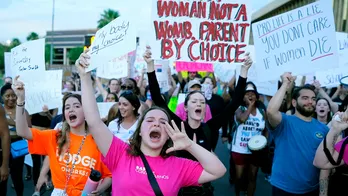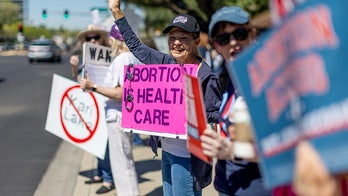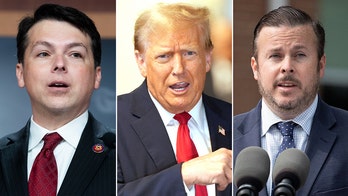Obama Tries to Put GOP On Defense Down South; Dems Deepen Associations With “Occupy” Movement
President Needs to Keep His Southern Foothold
“42 percent”
-- President Obama’s latest job approval rating in North Carolina according to a September survey from Elon University.
Barack Obama embarks on his second experiment in presidential retail politics today as he embarks on a bus trip across North Carolina and Virginia, his second effort to connect with voters on the ground in this election cycle.
Like the president’s first foray, a tour of the upper Midwest in August, Obama will be rolling in a blacked-out motor coach with an armada of security, support and press vehicles for the commander in chief (and this time, a tow truck helpfully offered by the North Carolina GOP).
While the president’s political team believes the junkets give the chance to “venture forth” and interact directly with voters, the bomb-proof bus and entourage may actually reinforce the president’s reputation as isolated and politically out of touch. It’s a traveling bubble but one that lacks the prestige of Air Force One.
But Obama needs to do something to turn things around in Virginia and North Carolina, and is taking advantage of the fact that he holds the general election discussion all to himself to do it.
Obama needs 270 Electoral College votes to win a second term in office, and Power Play’s Morning Line says that the president has a lock on 192 votes from invariably Democratic states. There are 191 Republican cotes that are utterly out of reach. That leaves 151 votes up for grabs.
The 28 votes from North Carolina and Virginia, though, aren’t just important on their own. They matter also because of how they will affect the rest of his electoral strategy.
In 2008, Obama was the first Democrat to win North Carolina since Jimmy Carter in 1976 and the first Democrat to win Virginia since Lyndon Johnson in 1964. He did it by building a coalition of enthusiastic black voters and students from the states’ many colleges and cutting into traditional Republican advantages among suburbanites and independents.
It looks like it will be hard for Obama to recapture that same coalition. Enthusiasm is down among black voters and youngsters and independents have fallen away from the president like autumn leaves.
But, if Obama can force the Republicans to invest resources Down South and spend time shoring up their own base, it gives Obama time and opportunity to shore up his support in traditionally blue states like Michigan and Pennsylvania and to compete for votes in super swings states like Nevada, Ohio and Florida. He would want Mitt Romney to have to spend time wooing evangelicals in Western North Carolina or Herman Cain, Rick Perry or Newt Gingrich to have to reassure Richmond suburbanites.
Just like Obama may not end up being able to hold Iowa, the scene of his first bus trip, there is wisdom in using this time when Republicans are preoccupied with their own fight to dominate local headlines and emphasize his message -- that the GOP shares the blame for the crummy economy because they won’t accept his call for a new stimulus package and tax increases on top earners.
While Republicans may doubt Obama’s ability to make it stick in traditionally red states, they have to recognize that Obama will be working this strategy relentlessly for months while their own nomination process plays out.
Obama Places MLK on the Side of Occupy Wall Street
“We forget now, but during his life, Dr. King wasn’t always considered a unifying figure. Even after rising to prominence, even after winning the Nobel Peace Prize, Dr. King was vilified by many, denounced as a rabble rouser and an agitator, a communist and a radical.”
-- Nobel Peace Price winner President Obama at the dedication of the Marin Luther King Jr. Memorial, where he talked about those who “rightly challenge the excesses of Wall Street” and his own calls for more government spending and higher taxes on top earners.
They’ve been occupying Wall Street for a month now and organizers can be happy to know that support for their movement has become a core view for the Democratic Party and for a president desperate to recreate the same enthusiasm on the left that launched him into the White House.
Republicans faced a similar dilemma in 2009 when their own team had just suffered the second of two repudiating elections and their own base was angry over the deviations from conservative orthodoxy from the previous eight years. The Tea Party offered energy and clear views for a party that lacked both.
Following the wave election of 2008 it was an open question if the only way forward for Republicans was to embrace a Tory style view of political opposition – not arguing about whether there should be a welfare state but offering ways to make it more efficient and more effective. Think David Brooks, “compassionate conservatism” and free prescription drugs for seniors.
But the protests that sprang up around Tax Day 2009 were not of that school. They were preaching Goldwater’s old-time religion of rolling back the state’s power and screaming for a return to constitutional concepts. It wasn’t the way that many in the Washington/New York corridor wanted to go, but since it’s hard to have a party without supporters, the GOP leadership eventually got on board. Rather than Republican lite, the GOP embraced the idea of 100-proof conservatism in the Obama era.
But it didn’t happen all at once and it took time before Republican leaders got on board. There were risks involved with identifying their party with a protest movement, especially one that was frequently described and racist and radical. But the August 2009 congressional town halls proved to the GOP grandees that they had better get on board or get rolled over.
By then, the movement had also shown it was not dominated by kooks or tolerant of ugliness.
For Democrats, though, the decision to embrace Occupy Wall Street has been swift and fairly complete.
Listen to President Obama at the dedication of the Martin Luther King monument:
“As was true 50 years ago, as has been true throughout human history, those with power and privilege will often decry any call for change as ‘divisive.’ They’ll say any challenge to the existing arrangements are unwise and destabilizing. Dr. King understood that peace without justice was no peace at all; that aligning our reality with our ideals often requires the speaking of uncomfortable truths and the creative tension of non-violent protest.”
The president strongly identified himself and his call for more government spending and higher taxes on top earners with the folks sleeping on the streets who were called into action first by a left-wing magazine in Canada.
After one month in action, Occupy Wall Street has become the toast of the Democratic Party, even receiving praise from the president in a speech at the dedication of one of his personal idols, Martin Luther King. David Axelrod made it clear that the movement would have its voice expressed in the fall campaign next year. Congressional Democrats are growing more effusive in their praise.
But these Democrats, glad to have some wind in their sails after three years of grueling governance often at odds with popular sentiment, ought to consider what they’ve been able to do with the Tea Party over time.
After years of a concerted effort by Vice President Joe Biden, Sen. Charles Schumer and lots of reporters in the establishment press and many others, “Tea Party” has become a political scare phrase used as a shorthand for conservative extremism.
If they could do that with a group that had its roots in the anger of a lot of middle aged and older working folks and retirees, how much faster will Republicans be able to make Democrats regret their association with a movement dominated by what the White House formerly derided as “the professional left,” especially given the strange sights, sounds and smells emanating from their encampments?




